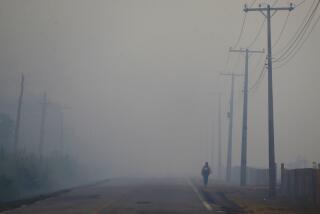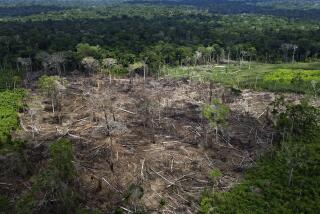ENVIRONMENT / PROGRESS IN BRAZIL : Crackdown Stems the Destruction of Amazon Forest
- Share via
BRASILIA, Brazil — Helio Pereira has prematurely gray hair at 34. It’s from his job, he says with a smile. Pereira is responsible for controlling deforestation in Brazil’s Amazon, a region 12 times the size of California.
The responsibility is daunting, but Pereira reports remarkable success. According to his calculations, Amazon forest razed this year will total about 1.7 million acres--down from nearly 6 million acres in 1988, when uncontrolled destruction of the world’s largest rain forest triggered international alarm.
The destruction has not stopped, but “the profile of deforestation in the Amazon has changed, about that there is no doubt,” Pereira said in an interview.
The improvement has resulted largely from changes in government policy and an increasingly effective program of controls by the Brazilian Institute for Natural Environment and Renewable Resources, known as IBAMA. Pereira, a forestry engineer, is in charge of IBAMA’s enforcement task force.
Efforts have focused on large cattle ranches, many covering hundreds of thousands of acres. In 1988 and 1989, ranchers were slashing and burning large tracts of forest that averaged about 12,000 acres each, according to Pereira. So far in 1990, the biggest tract burned was 3,200 acres, he said. Most of the deforestation is now being done by small farmers.
American satellite images showing Amazon fires are used to help map forest destruction in Pereira’s “control room” at IBAMA headquarters on the edge of Brasilia. Pointing at maps lining the walls, he said the number of fires detected by satellite dropped from 59,000 in 1989 to 9,080 so far in 1990.
All but 239 of this year’s fires occurred in June, Pereira said. In past years, heavy burning took place from June through August, the driest months, but tough restrictions this year broke the pattern.
IBAMA sends the satellite data to its 76 offices in the Amazon. Army communications personnel help relay the data by radio to field agents. Six helicopters conduct aerial surveillance. And agents in 60 pickup trucks zero in on suspected violators.
About 130 IBAMA agents, 60 federal police officers and 110 agents from state governments in the Amazon region are assigned to the program, being carried out on a tight budget of $1.2 million for 1990.
The humid forest covering burns well only if it has been cut down and left to dry for more than a month before it is set on fire. So ranchers and farmers usually begin clearing forest areas in April.
That was when IBAMA’s control program began this year. Agents spread out over the southern side of the Amazon, where deforestation has been heaviest, looking for logging trucks and picking up information from cooperative residents.
IBAMA levies fines for cutting or burning without authorization and for transporting logs without permits. Last year, it levied $3 million in fines, but only 1.2% were paid. Under current law, which IBAMA wants to change, landowners may appeal the fines, and property cannot be seized to force payment.
This year, to collect fines from loggers IBAMA began confiscating valuable hardwood being transported without permits. As a result, 70% of $1.2 million in 1990 fines have been collected, Pereira said.
He said the crackdown on loggers also has helped to slow deforestation because they often provide financing for clearing operations.
During the 1970s and 1980s, when official policy encouraged agriculture in the Amazon, the government gave generous tax breaks and other subsidies to ranchers in the region. Those incentives were suspended last year.
The law still allows landowners to clear 50% of the forest from their properties, however, and IBAMA still must issue clearing permits to farmers who legally claim them. But in the southern Amazon states of Acre, Para and Rondonia, the total of authorized forest-clearing fell from 1.5 million acres in 1989 to 500,000 acres this year, Pereira said.
“We are making that authorization as difficult as we can,” he said.
Although the government Bank of the Amazon still finances some forest clearing, Pereira said such lending has sharply dropped this year. In August, the government banned official financing for agriculture north of the 13th parallel, which skirts the southern edge of the Amazon region.
Tania Munoz, president of IBAMA, said some interest groups oppose her agency’s efforts to control deforestation, but she has the important backing of President Fernando Collor de Mello.
“There is a national awareness that the ecology issue is being led by President Collor, and that makes anyone think twice before rebelling,” Munoz said.
More to Read
Sign up for Essential California
The most important California stories and recommendations in your inbox every morning.
You may occasionally receive promotional content from the Los Angeles Times.










